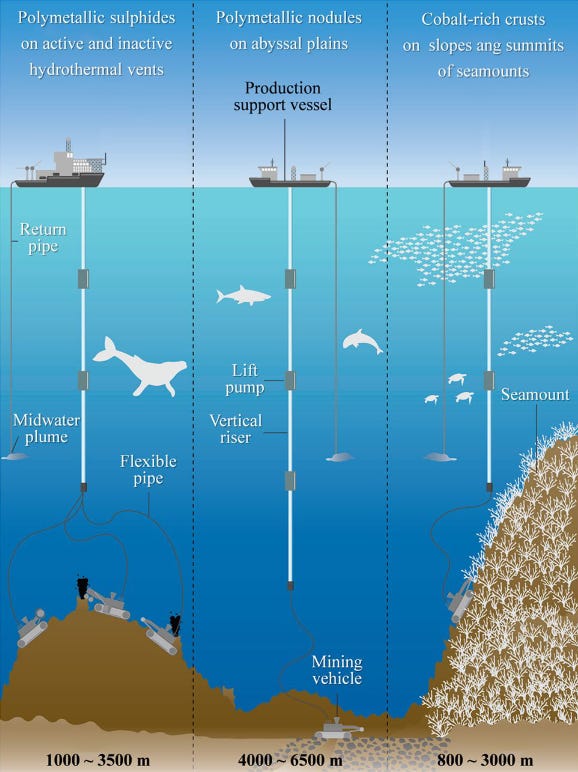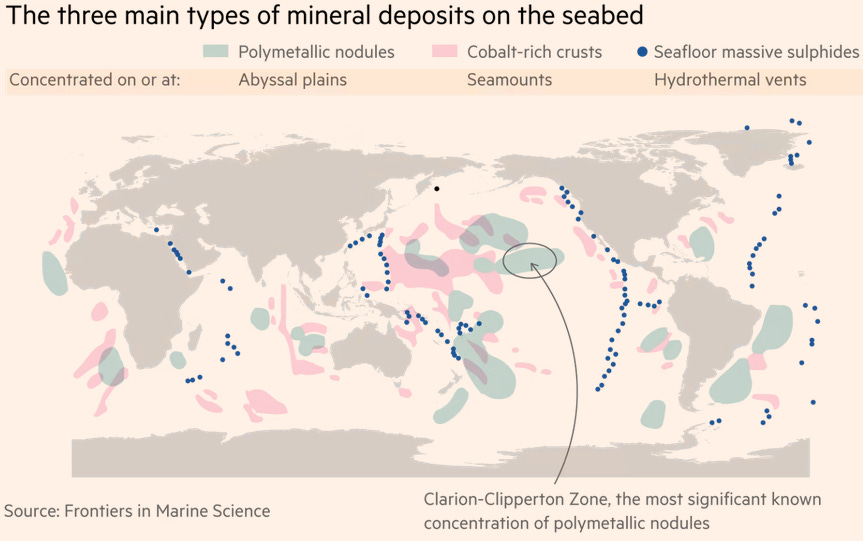Mining the Seven Seas
Deep-sea mining as the next frontier in the technological race to the bottom
Thank you for reading Lithium Horizons. Here we explore energy, innovation, and ideas from the frontiers of materials. You can subscribe for free to receive new posts directly in your inbox.
Vast ocean floors are quickly becoming the next frontier in geopolitical rivalries. This wild west beyond national jurisdiction presents untold material riches, from critical minerals to hydrocarbons. Elements like copper, zinc, cobalt, lithium, nickel, manganese, silver, and gold are all needed for the proper functioning of our modern world and they can all be found at the bottom of the seas.
Extracting minerals from the oceans is dubbed seabed mining and it can potentially cause severe environmental issues as the practice disturbs the aquatic ecosystem. I say potentially because we just don’t know enough about deep-sea flora and fauna to make informed decisions. As Cindy van Dover said in 2013: ‘‘We don't yet know what we need to know.‘‘
So what exactly is seabed mining?
Seabed mining1 refers to the recovery of minerals through underwater mining of seabeds. A seabed is the floor of the sea. The ocean is deepest in the Mariana Trench, where the seabed is found at a depth of 10909 meters (i.e. deeper than the height of Mount Everest). You can imagine the difficulty of such an enterprise, which is usually done by deploying remotely operated robots that plow the seabed. Then, the collected material is sent to a surface platform or ship where initial processing is done, before sending the materials to some onshore facility for further processing.

The mineral deposits that can be found at the bottom of the oceans can be classified into three categories: polymetallic nodules, cobalt-rich crusts, and sulfides. Polymetallic nodules are round objects consisting mostly of iron and manganese oxides, in addition to smaller amounts of cobalt, nickel, and copper. Cobalt-rich crusts are expectedly rich in cobalt, but also manganese. Sulfides arise along volcanically active regions and are rich in copper, zinc, gold, and silver.

That is a lot of economically-critical materials just lying in international waters. The Clarion-Clipperton fracture zone is of particular interest due to the abundant presence of manganese. In fact, it contains 5992 million tonnes of manganese, while global reserves and resources of manganese on land are 5200 million tonnes. Similarly, it contains 274 million tonnes of nickel, more than the 150 million tonnes you can find on land. There are also 44 million tonnes of cobalt (vs the 13 million tonnes on land). This 4.5 million square kilometers area of the Pacific Ocean is incredibly rich in resources that are particularly needed for advanced technologies. If you couple it with the fact that there is enough gold down there to be worth $150 trillion, the question becomes why haven’t we exploited it already?
The correct answer is technological constraints.
Any deep-sea mining solution will have to work under challenging conditions of high pressures, low temperatures, strong currents, changing topography, and variable sediment compactness. This extreme environment necessitates extreme engineering solutions. And extreme engineering is not exactly low-cost, so traditionally it has been cheaper to extract minerals on land than from the bottom of the seas.
Nowadays, we don’t exactly have much choice, we are facing a shortage of critical minerals. So deep-sea mining is rearing its head as a potential solution to this problem. Several countries have started running pilot projects to assess the economic and technological viability of deep-sea mining. If the results are encouraging, there will be a gold rush. On one hand, this will likely propel the global economy, supplying the much-needed materials for batteries, solar panels, wind turbines, smartphones, automobiles, and other advanced technologies.

On the other hand, it may cause a period of political instability, with competing nations vying for the same resources. Furthermore, great environmental damage is almost guaranteed. A 2016 study of the Clarion-Clipperton Zone seabed found it to be home to numerous species, more than half of whom were previously unknown. How many more species are there, that would’ve been harmed if we proceeded to deep-sea mine without proper study of the ocean flora and fauna? It is very likely that extensive seabed mining would cause irreparable harm to the marine ecosystem and put the health of the wider ocean at risk.
Fundamental knowledge gaps persist in our understanding of the oceans and the effect of deep-sea mining. The connectivity between seabed habitats and the broader biosphere is poorly understood. This is complicated by regulatory uncertainties, as there is no vision of how many commercial operations are sustainable in an area. There is a vital need for extensive primary research that can guide informed decision-making. As it stands, we are opening a Pandora’s box.
That’s all for now. Until next time 🔋!
Thank you for reading this article, I hope you enjoyed it! Feel free to share it with your friends.
I am using the terms ‘‘seabed mining’’ and ‘‘deep-sea mining’’ interchangeably. They have a similar, but not exactly the same meaning. While seabed mining denotes mining any seabed, deep-sea refers to mining at depths of more than 200 meters.



